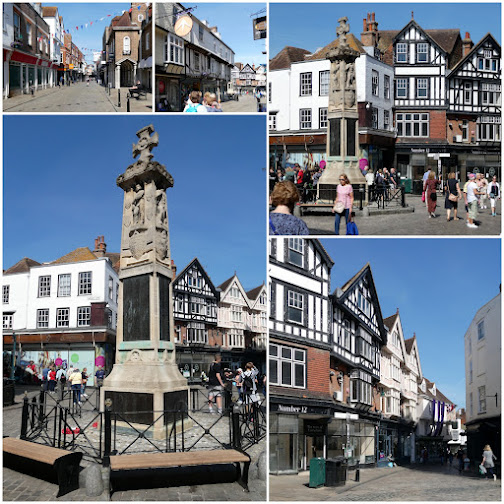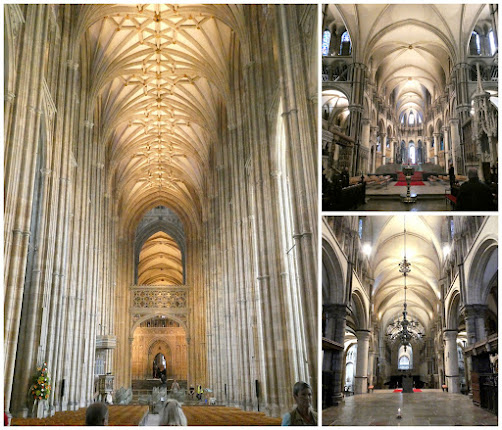After our scenic arrival at the port of Dover, England, Tim and I boarded a motorcoach for the included tour of Historic Canterbury. Canterbury is a beautiful city and one of England’s most important religious destinations. We were dropped off at Whitefriars Shopping Center of all places, and here we met our guide and began our walking tour of the city’s main sights.
Our introduction to Canterbury was a bronze sculpture of a lamb standing on a tall tree stump. This imagery seemed appropriate in a city with such a long history of pilgrimages and religious orders. We learned about the city’s Roman past and one of the largest urban archeological excavations ever undertaken in England prior to the construction of the shopping center. Remains of a Roman tower found during the dig are on display in a permanent exhibit, and we caught a glimpse of the wall in a window display at Whitefriars.
 |
| A Roman Wall and a Lamb |
We made our way to St. George's Tower, which was originally the bell tower of St. George’s Church. The church was destroyed during Canterbury’s worst bombing raid of World War II, but the tower and clock have since been restored.
 |
| St. George's Tower |
We passed St. Thomas’ Catholic Church and the adjacent St. Mary Magdalene Tower and then followed our guide to the Buttermarket. Buttermarket was the center of medieval Canterbury, and the buildings lining the square were once inns that housed early pilgrims to the city. The center of the square is marked by World War I memorial.
 |
| St. Thomas’ Catholic Church and St. Mary Magdalene Tower |
 |
| Buttermarket |
We didn’t see much of the city on our walking tour, but Tim and I were most looking forward to visiting Canterbury Cathedral on our own. The included tour served to get us to Canterbury.
Canterbury Cathedral, a UNESCO World Heritage Site, dominates the heart of the city, and many consider it a miracle that it was not destroyed during the bombing raids in World War II. Founded in 597, the Cathedral was completely rebuilt in the eleventh century. It is one of the most important churches in England and seat of the of the Church of England and its leader, the Archbishop of Canterbury.
The imposing Christ Church Gate entrance to the Cathedral Precincts was not so imposing today. Scaffolding and sheeting concealed the major restoration project that is currently underway. Likewise, we discovered that scaffolding surrounded the west front of the Cathedral. A look upward at the tower revealed the restoration and cleaning that had already taken place. It would be great to see the final reveal.
 |
| Christ Church Gate and Canterbury Cathedral Under Wraps |
 |
| Many of the Exterior Features Were Still Visible |
We entered the Cathedral through the nave, straining our necks to look upward in this magnificent space. We then moved through the Quire and Trinity Chapel, located at the east end of the church. Completed in 1184 as a shrine to St. Thomas Becket, today it is dedicated to “saints and martyrs of our own time.”
 |
| The Nave, Quire, and Trinity Chapel |
One could spend hours discovering the various architectural elements, stained glass, and other details that comprise this spectacular edifice. We didn’t have that much time, but we made the most of it. We exited the church and walked through the Cloisters, a covered colonnade that encloses a courtyard attached to the side of the Cathedral.
 |
| Details of Canterbury Cathedral |
 |
| The Cloister |
Our visit to Canterbury and the Cathedral was a quick one, but I’m grateful that we were able to visit this historic place.

No comments:
Post a Comment